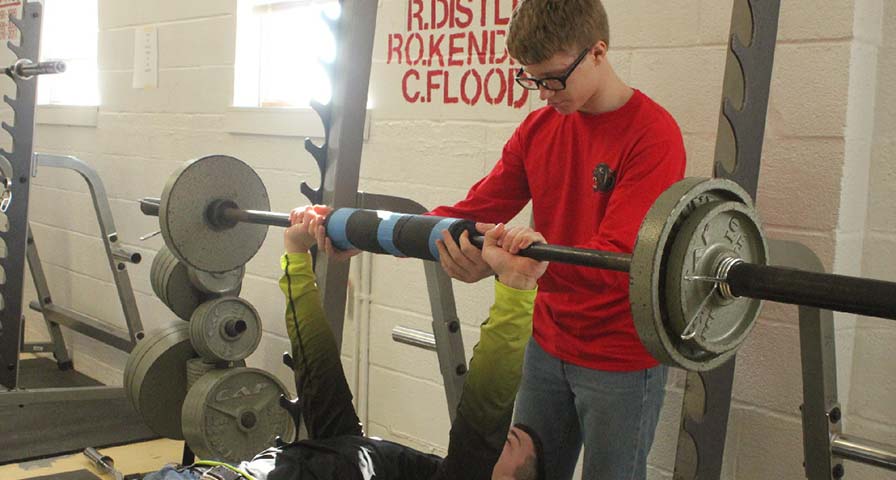Originally published Dec. 26, 2018 in the California Democrat.
By Liz Morales
The Missouri Consultants for Education recommend schools within the state do what they can to not only educate Missouri’s youth, but to keep them healthy while in school.
According to the MCE website, “research shows that good nutrition and physical education before and after school are correlated strongly with positive student outcomes.”

Kaleb Craig benches iron in the weightlifting room at Prairie Home High School while Damian Crowe spots his progress. Craig and Crowe are both freshmen at Prairie Home High School and are in the district’s weightlifting class. (Liz Morales photo)
This notion has led the organization to implement a policy to ensure Missouri’s youth have a well-rounded chance of maintaining wellness when in school. The wellness policy dictates each school must have a wellness committee that meets at least four times per year. The committee must integrate district nutrition and physical activity in the curriculum, ensure staff have professional development that includes nutrition and physical activity issues and ensure students receive nutrition education and rigorous physical activity.
The superintendent and/or designee must oversee the committee and help to develop and update the wellness policy of their own district as needed.
On a nutritional standpoint, the state requires schools to serve healthy meals to students with fruits, vegetables, whole grains and fat-free and low-fat milk options. Students must also have access to food that is moderate in sodium, low in saturated fat and have zero grams trans fat per serving.
There must also be a unit of nutritional education for students that covers a minimum of 12 out of 24 essential topics that may include balancing food intake with physical activity, food safety and even social influences on healthy eating, including media, family, peers and culture.
Prairie Home Superintendent Michele Rex knows a thing or two about health for younger minds and bodies, as she is a former physical education teacher. She and her staff have maintained a strict protocol when it comes to their student’s nutritional needs.
“We maintain a low sodium and low sugar diet here for lunch,” Rex said. “There are also a lot of fresh fruits and vegetables here, along with a salad bar. Students have to sign up, in order to eat the salads.”
Students are highly encouraged to drink water. A juice machine the district carries offers a wide variety of healthy drinks and teas, with one lone machine of soda that is housed in 10-ounce cans.
“The water vending machine is on all day, but the soda machine is not,” Rex said. “The coke machine is only open just before and just after school hours.”
If a student, or even staff member, walks into the building first thing in the morning with any fluid, in a clear container, that doubles as soda, they must throw it out.
“But they can have water bottles in the classrooms,” Rex said.
To further the education of nutritional diets, Prairie Home publishes something called “Nutrition Nuggets.” Nutrition Nuggets is a weekly printed informational sheet of “little tidbits” relating to nutrition facts for students to enjoy.
Clarksburg C-2 also keeps a close watch on the foods their students eat while during academic hours. Clarksburg physical education teacher Casey Anderson said the basis of this careful nutrition is a familiar one.
“We follow state guidelines in regards to protein, sugar, salt, vegetables, dairy, etc.” Anderson said. “We also incorporate fresh fruit and vegetables as often as possible.”
The fresh fruits and vegetables come from a nearby source.
“We have a school garden in which the students help maintain that, and we incorporate fresh items from that into our lunches,” Anderson said. “Also, our students have an option to choose a salad for a main entree over what is offered that day.”
Anderson said each menu the school writes is submitted to the state to be “subject for review.”
“(The menus) are closely monitored by the state,” she said. “We had an onsite review the year before last and they audit everything top to bottom.”
As per state standards, the key to maintaining students’ complete wellness also encompasses a tight regimen on physical education. The state mandates children and adolescents need at least 60 minutes of physical activity each day, as well as physical activities before and after school hours.
“All the students have to stay active,” Rex emphasized. “We recognize and educate the students to know that every body is different and that there are health implications that may be different from person to person. We’re trying to bring forth programs and newer health books that push body differentiation.”
Another new program to be implemented at Prairie Home is to make sure each student walks around the gym once they arrive on campus until the school day begins.
As soon as younger elementary students arrive at school in Prairie Home, they have the option to eat breakfast and then go to recess. Students in grades kindergarten up to second grade have recess a couple of times per day for 25 minutes. If the weather outside is unfavorable, the children may walk around the gym perimeter until the school day begins.
Seventh- and eighth-grade students at Prairie Home have physical education and health classes daily. In health, they learn CPR techniques among a variety of health measures.
The older students have the option to take lifetime sports or weightlifting — two classes that are offered for four hours throughout each day.
“The students are required to take one credit of P.E. each day, after that, they don’t have to do the other stuff,” Rex said of the additional physical education courses. “Students definitely take advantage of it, though.”
Seeking IHT Spirit System information?




